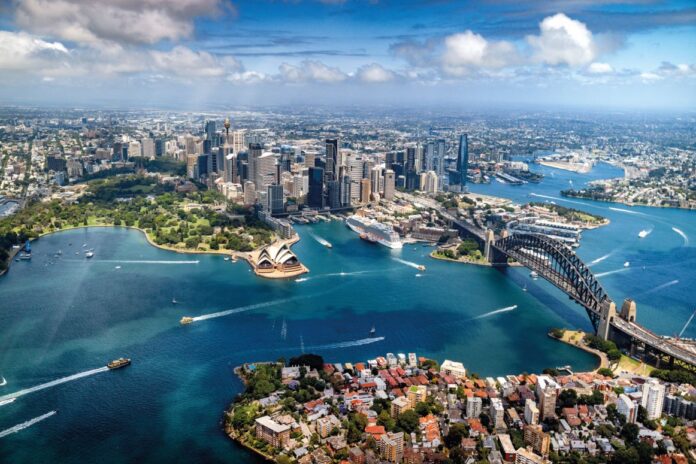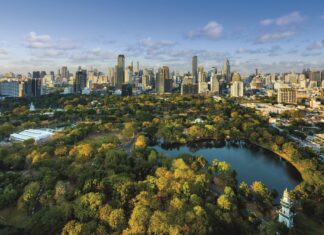Simon Fane, Ann-Marie Rohlfs and Ebony Heslop describe a project that is improving the resilience of Greater Sydney’s drinking water catchments by scoping future scenarios in 2040 and 2060.
WaterNSW is a state-owned corporation in New South Wales (NSW), Australia, responsible for capturing, storing and delivering two-thirds of the bulk water used in NSW, including managing Greater Sydney’s bulk water supply and drinking water catchments.
WaterNSW partnered with the University of Technology Sydney Institute for Sustainable Futures (UTS-ISF) to help protect drinking water catchments for future generations, particularly in the face of megatrends such as digital transformation, climate change and population growth.
Through collaborative workshops, UTS-ISF’s expert knowledge across a range of fields (including water, energy, smart cities and climate change) and WaterNSW’s on-ground experience were combined within six detailed scenarios that explore plausible futures for Greater Sydney’s water catchments.
This multidisciplinary project demonstrates effective integration of creative and critical thinking to expand the scope of traditional modelling, which has proven essential for approaching complex issues such as water security. These scenarios are aiding planning and decision-making today to prepare for an uncertain future and show how water authorities can take steps to prepare for both challenging and positive aspects of the future.
Explaining the research
Development of a series of future scenarios for Greater Sydney’s drinking water catchments was achieved through a three-phase project approach.
The first phase involved a literature review and horizon scan undertaken by UTS-ISF to identify megatrends and drivers on global and local scales that could impact Greater Sydney’s water catchment systems.
In the second phase, WaterNSW experts across a range of interests participated in two collaborative workshops facilitated by UTS-ISF to first envision possible futures and then help develop future scenarios.
The methodology combined the qualitative outputs from the stakeholder workshops with the quantitative spatial modelling of land use and land cover (LULC) to produce future scenarios defined by both narratives and LULC maps of the future in 2040 and 2060. This also included the baseline scenario considered in 2019 and projected to 2040 and 2060. This enabled a comparison of each scenario to the expected future. Thirty years of historical catchment LULC transitions were modelled and projected forward from 2019 to give future LULC maps in 2040 and 2060. The anticipated effects of climate change as forecast for NSW in Australian Regional Climate Modelling were built into this baseline scenario.
After constructing the baseline spatial model and adjusting this to represent future scenarios, the scenarios were presented as a collation of their respective narrative, modelling approach and spatial outputs. These outputs are GIS maps that can be used in water quality modelling. The final scenarios encompass a range of plausible outcomes for Greater Sydney’s water catchment futures, characterised by differing catchment, carbon, and treatment results.

Scenarios
Three of the six scenarios developed are summarised here.
Scenario 1: Envisages increased investment in catchment management as a key strategy for providing safe drinking water to Greater Sydney. This is achieved through collaboration between the State Government, WaterNSW, Aboriginal Traditional Owners, local communities and industries. A long-term commitment to the value of catchment management is a key driver of this scenario. The resulting improvements in water quality and catchment health will positively influence liveability, resilience, ecology, and economic opportunities in catchment areas. Population growth remains at the baseline rate, but will become more condensed in catchment areas, resulting in decreased disturbance to land and increased reforestation.
This scenario emphasises the importance of community engagement and the role of Traditional Owners in managing and protecting water resources. By fostering collaboration and shared responsibility, this scenario aims to create a resilient and sustainable water catchment system that can adapt to future challenges.
Scenario 2: Is characterised by the implementation of green, blue and grey features in urban and agricultural development. Shifting community demands for integrated green spaces, water and localised industries increase pressure on catchment management. Government engagement in response to the increased cost of living in Sydney results in the development of regional towns into new urban centres, driven by a new high-speed rail network. The urban footprint in Scenario 2 is expected to remain consistent with baseline rates. However, urban densification is directed towards rural centres, as opposed to continued rapid expansion in south-western Sydney. This will coincide with continued flexible work-from-home schedules. This projection is already being realised, with the Australian Government High Speed Rail Authority having announced phase one of the east coast high-speed rail network (Australian Government, 2024).
This scenario highlights the importance of integrating green infrastructure into urban planning to enhance resilience and sustainability. More sophisticated water management is critical to supporting liveability in these areas and downstream drinking water quality supplied to Greater Sydney. Green infrastructure, such as parks, green roofs and urban forests, can help mitigate the impact of climate change, improve air and water quality, and provide recreational spaces for communities.
Scenario 3: Envisions WaterNSW as a manager of a carbon-positive catchment. This is facilitated by government incentives that support Australia achieving zero carbon emissions by 2050.
Renewable energy and biodiversity restoration processes enable improved carbon capture and water quality, as well as providing carbon offsets within the catchment area. Reforms to land management are supported by the public as both economic and environmental profit is acquired. This scenario creates new job opportunities in carbon and renewables sectors, leading to a slight increase in population density in rural centres. This, however, does not increase the urban footprint as a result of the carbon-positive initiatives implemented.
Achieving a carbon-positive catchment involves a combination of strategies, including reforestation, wetland restoration and the adoption of renewable energy technologies. These initiatives not only help mitigate climate change, but also enhance the resilience of water catchments by improving water quality and biodiversity. Public support and participation are crucial in this scenario, as community involvement in conservation and sustainability efforts can drive positive change and ensure the long-term success of these initiatives.

How the research is being used
While no future scenario can be expected to unfold exactly as described, they are useful tools for considering previously unexperienced conditions and testing potential solutions. WaterNSW is already acting on Scenario 3, which addresses a carbon-positive catchment. They are investigating ways to generate revenue from carbon sequestration, biodiversity regeneration, and supporting the low-carbon transition through renewable energy generation, transmission and storage projects.
Across the scenarios, the outputs produced are aiding planning and decision-making by water authorities today to protect drinking water for future generations. The scenarios provide a framework for exploring different adaptation pathways and identifying potential risks and opportunities for core business priorities. By considering a range of plausible futures, water authorities can develop more robust and resilient strategies that are better equipped to handle uncertainty and change.
The collaborative and multidisciplinary approach used in this project demonstrates the value of integrating diverse perspectives and expertise in resilience planning. By involving stakeholders with various perspectives and incorporating qualitative and quantitative methods, the project has produced comprehensive and well-rounded scenarios that address the complexity of water catchment management. This approach can serve as a valuable model for other regions facing similar challenges and can help inform future resilience planning efforts.
The authors: Dr Simon Fane is Research Director and Associate Professor at UTS-ISF;
Dr Ann-Marie Rohlfs is Water Science Lead, WaterNSW; and Ebony Heslop is Research Principal at UTS-ISF








